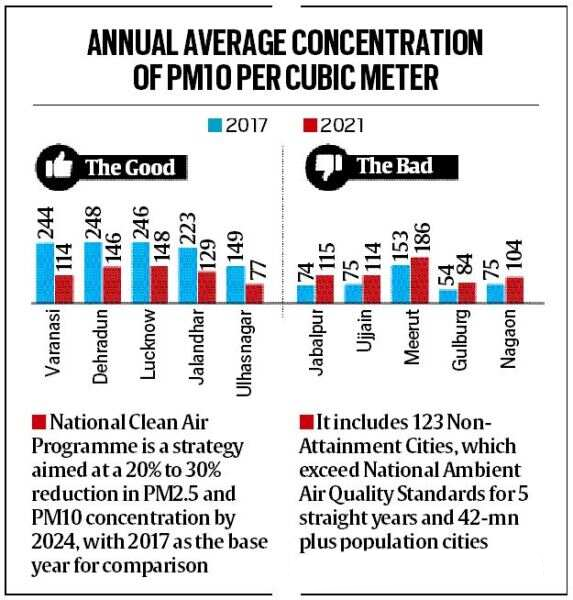Biodiversity & Environment
International Day of Clean Air for Blue Skies
- 08 Sep 2022
- 5 min read
For Prelims: National Clean Air Programme, PM 10, PM 2.5, UNEP.
For Mains: International Day of Clean Air for Blue Skies, its Significance.
Why in News?
Recently, the Ministry of Environment, Forest and Climate Change (MoEF&C) organized 3rd International Day of Clean Air for blue skies as ‘Swachh Vayu Diwas (“Swachh Vayu Neel Gagan”) ’today to raise awareness and facilitate actions to improve air quality under National Clean Air Programme (NCAP).
- 20 cities selected out of 131 for its National Clean Air Programme (NCAP) have attained the National Ambient Air Quality Standards (60 microgram per cubic meter) in 2021-22, compared to their 2017 levels.
What are the Key Points?
- Theme:
- The theme is “The Air We Share”.
- It highlights the need for immediate and strategic international and regional cooperation for more efficient implementation of mitigation policies and actions to tackle air pollution.
- About:
- During its 74th session, the United Nations General Assembly adopted a resolution to hold an International Day of Clean Air for Blue Skies on 19th December, 2019.
- The resolution also encouraged the United Nations Environment Programme (UNEP) to facilitate the day’s observance in collaboration with other relevant stakeholders.
- In the lead-up to the passing of the resolution, the Climate and Clean Air Coalition collaborated with UNEP and the Republic of Korea to advocate for the day.
- Significance:
- The United Nations commemorates the International Day of Clear Air for Blue Skies by hosting summits with member states.
- Attendees put forth their perspectives and discuss the data on the impacts of air pollution and air quality around the globe.
What are the Findings of NCAP?
- Ninety-five of these 131 cities have shown air quality improvement,
- Varanasi recorded the most marked improvement — of 53% — in air quality levels.
- Varanasi had an annual average concentration of PM10 of 244 in 2017, which dropped to 144 in 2021.
- PM10 for all metropolitan cities, Delhi, Bengaluru, Mumbai, Chennai, Kolkata and Hyderabad, have shown significant improvement in air quality in 2021-22 compared to 2017.
- Other major cities to have shown an improvement include Noida, Chandigarh, Navi Mumbai, Pune, Guwahati, etc.
- But 27 cities have shown a deterioration in air quality over the same period.
- Among them is Korba — the district in Chhattisgarh houses 10 thermal coal power plants.
- Among states, Madhya Pradesh has been the poorest performer, as six of seven cities from the state selected by the Centre for NCAP have shown a deterioration in air quality.
- These are Bhopal, Dewas, Indore, Jabalpur, Sagar, Ujjain and Gwalior.
- Howrah and Durgapur in West Bengal, Aurangabad and Thane in Maharashtra, Gaya in Bihar, Rajkot and Vadodara in Gujarat, Bhubaneswar (Odisha), Patiala (Punjab) and Jammu, among others, have also shown a worsening of air quality.
UPSC Civil Services Examination, Previous Year Questions (PYQs)
Prelims
Q. Consider the following statements: (2017)
- Climate and Clean Air Coalition (CCAC) to Reduce Short Lived Climate Pollutants is a unique initiative of G20 group of countries.
- The CCAC focuses on methane, black carbon and hydrofluorocarbons.
Which of the statements given above is/are correct?
(a) 1 only
(b) 2 only
(c) Both 1 and 2
(d) Neither 1 nor 2
Ans: (b)
Exp:
- The Climate and Clean Air Coalition is a voluntary partnership of governments, intergovernmental organizations, businesses, scientific institutions and civil society organizations committed to improving air quality and protecting the climate through actions to reduce short-lived climate pollutants. Hence, statement 1 is not correct.
- The Coalition’s initial focus is on methane, black carbon, and hydrofluorocarbons (HFCs).
- The governments of Bangladesh, Canada, Ghana, Mexico, Sweden and the United States, along with the United Nations Environment Programme (UNEP), came together to initiate the first effort to treat these pollutants as a collective challenge. Hence, statement 2 is correct.
- India is not a partner country, but The Energy and Resources Institute (TERI) has been a partner NGO since 2015. Therefore, option (b) is the correct answer.





